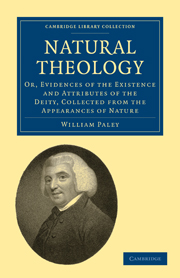 Natural Theology
Natural Theology Published online by Cambridge University Press: 07 September 2010
We have already confidered relation, and under different views; but it was the relation of parts to parts, of the parts of an animal to other parts of the fame animal, or of another individual of the fame fpecies.
But the bodies of animals hold, in their conftitution and properties, a clofe and important relation to natures altogether external to their own; to inanimate fubftances, and to the fpecific qualities of thefe, e. g. they hold a ftrict relation to the ELEMENTS by which they are furrounded.
I. Can it be doubted, whether the wings of birds bear a relation to air, and the fins of fifh to water? They are inftruments of motion, feverally fuited to the properties of the medium in which the motion is to be performed: which properties are different. Was not this difference contemplated, when the inftruments were differently conftituted?
II. The ftructure of the animal ear depends for its ufe not fimply upon being furrounded by a fluid, but upon the fpecific nature of that fluid. Every fluid would not ferve: its particles muft repel one another; it muft form an elaftic medium: for it is by the fucceffive pulfes of fuch a medium, that the undulations excited by the founding body are carried to the organ; that a communication is formed between the object and the fenfe; which muft be done, before the internal machinery of the ear, fubtile as it is, can act at all.
To save this book to your Kindle, first ensure [email protected] is added to your Approved Personal Document E-mail List under your Personal Document Settings on the Manage Your Content and Devices page of your Amazon account. Then enter the ‘name’ part of your Kindle email address below. Find out more about saving to your Kindle.
Note you can select to save to either the @free.kindle.com or @kindle.com variations. ‘@free.kindle.com’ emails are free but can only be saved to your device when it is connected to wi-fi. ‘@kindle.com’ emails can be delivered even when you are not connected to wi-fi, but note that service fees apply.
Find out more about the Kindle Personal Document Service.
To save content items to your account, please confirm that you agree to abide by our usage policies. If this is the first time you use this feature, you will be asked to authorise Cambridge Core to connect with your account. Find out more about saving content to Dropbox.
To save content items to your account, please confirm that you agree to abide by our usage policies. If this is the first time you use this feature, you will be asked to authorise Cambridge Core to connect with your account. Find out more about saving content to Google Drive.